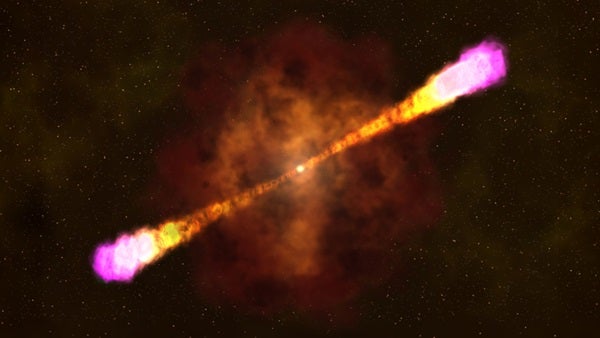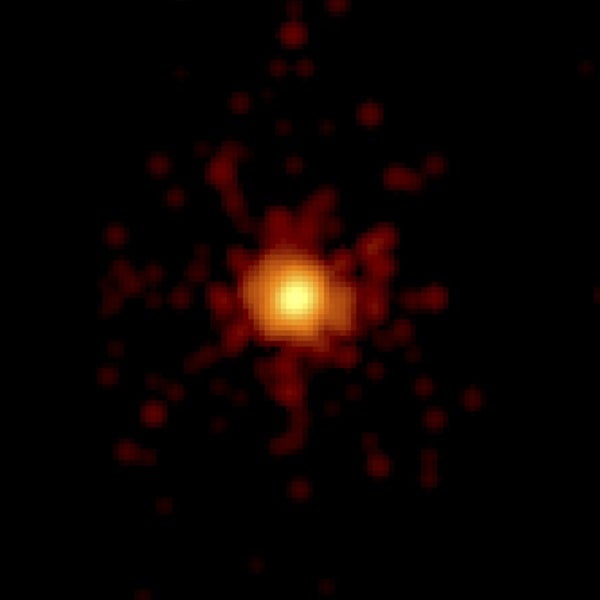On April 27, a blast of light from a dying star in a distant galaxy became the focus of astronomers around the world. The explosion, known as a gamma-ray burst (GRB) and designated GRB 130427A, tops the charts as one of the brightest ever seen.
A trio of NASA satellites, working in concert with ground-based robotic telescopes, captured never-before-seen details that challenge current theoretical understandings of how GRBs work.
“We expect to see an event like this only once or twice a century, so we’re fortunate it happened when we had the appropriate collection of sensitive space telescopes with complementary capabilities available to see it,” said Paul Hertz from NASA’s Astrophysics Division in Washington, D.C.
GRBs are the most luminous explosions in the cosmos, thought to be triggered when the core of a massive star runs out of nuclear fuel, collapses under its own weight, and forms a black hole. The black hole then drives jets of particles that drill all the way through the collapsing star and erupt into space at nearly the speed of light.
Gamma rays are the most energetic form of light. Hot matter surrounding a new black hole and internal shock waves produced by collisions within the jet are thought to emit gamma rays with energies in the million-electron-volt (MeV) range, or roughly 500,000 times the energy of visible light. The most energetic emission, with billion-electron-volt (GeV) gamma rays, is thought to arise when the jet slams into its surroundings, forming an external shock wave.
The Gamma-ray Burst Monitor (GBM) aboard NASA’s Fermi Gamma-ray Space Telescope captured the initial wave of gamma rays from GRB 130427A shortly after 3:47 a.m. EDT April 27. In its first three seconds alone, the “monster burst” proved brighter than almost any burst previously observed.
“The spectacular results from Fermi GBM show that our widely accepted picture of MeV gamma rays from internal shock waves is woefully inadequate,” said Rob Preece from the University of Alabama in Huntsville.
Telescopes operated by Los Alamos National Laboratory in New Mexico as part of the Rapid Telescopes for Optical Response (RAPTOR) Project quickly turned to the spot. They detected an optical flash that peaked at magnitude 7 on the astronomical brightness scale, easily visible through binoculars. It is the second-brightest flash ever seen from a GRB.
Just as the optical flash peaked, Fermi’s Large Area Telescope (LAT) detected a spike in GeV gamma rays reaching 95 GeV, the most energetic light ever seen from a burst. This relationship between a burst’s optical light and its high-energy gamma rays defied expectations.
“We thought the visible light for these flashes came from internal shocks, but this burst shows that it must come from the external shock, which produces the most energetic gamma rays,” said Sylvia Zhu from the University of Maryland in College Park.
The LAT detected GRB 130427A for about 20 hours, far longer than any previous burst. For a gamma-ray burst, it was relatively nearby. Its light traveled 3.8 billion years before arriving at Earth, about one-third the travel time for light from typical bursts.
“Detailed observations by Swift and ground-based telescopes clearly show that GRB 130427A has properties more similar to typical distant bursts than to nearby ones,” said Gianpiero Tagliaferri from the Brera Observatory in Merate, Italy.
This extraordinary event enabled NASA’s newest X-ray observatory, the Nuclear Spectroscopic Telescope Array, to make a first-time detection of a burst afterglow in high-energy, or “hard,” X-rays after more than a day. Taken together with Fermi LAT data, these observations challenge long-standing predictions.











